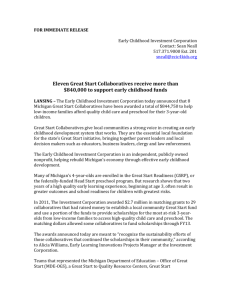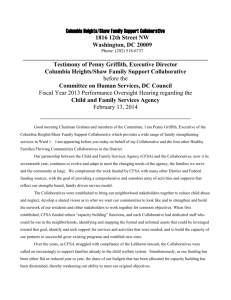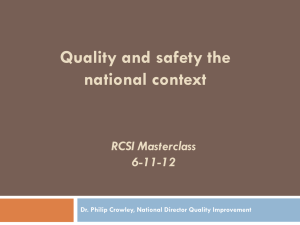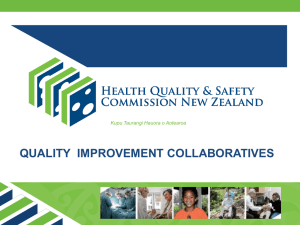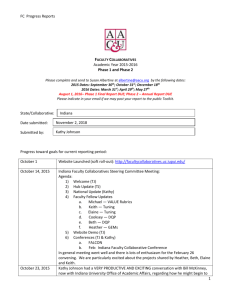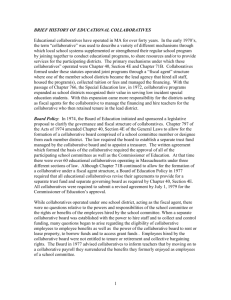Don’t Stop Collaborating – Just Stop Creating New Collaboratives
advertisement
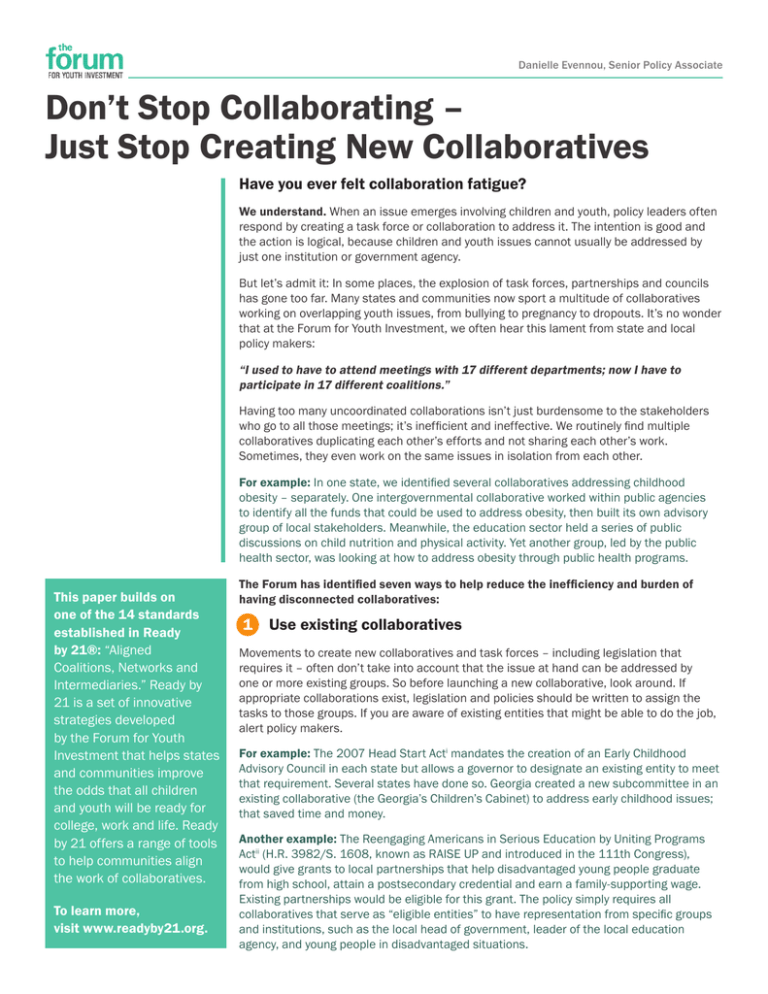
Danielle Evennou, Senior Policy Associate Don’t Stop Collaborating – Just Stop Creating New Collaboratives Have you ever felt collaboration fatigue? We understand. When an issue emerges involving children and youth, policy leaders often respond by creating a task force or collaboration to address it. The intention is good and the action is logical, because children and youth issues cannot usually be addressed by just one institution or government agency. But let’s admit it: In some places, the explosion of task forces, partnerships and councils has gone too far. Many states and communities now sport a multitude of collaboratives working on overlapping youth issues, from bullying to pregnancy to dropouts. It’s no wonder that at the Forum for Youth Investment, we often hear this lament from state and local policy makers: “I used to have to attend meetings with 17 different departments; now I have to participate in 17 different coalitions.” Having too many uncoordinated collaborations isn’t just burdensome to the stakeholders who go to all those meetings; it’s inefficient and ineffective. We routinely find multiple collaboratives duplicating each other’s efforts and not sharing each other’s work. Sometimes, they even work on the same issues in isolation from each other. For example: In one state, we identified several collaboratives addressing childhood obesity – separately. One intergovernmental collaborative worked within public agencies to identify all the funds that could be used to address obesity, then built its own advisory group of local stakeholders. Meanwhile, the education sector held a series of public discussions on child nutrition and physical activity. Yet another group, led by the public health sector, was looking at how to address obesity through public health programs. This paper builds on one of the 14 standards established in Ready by 21®: “Aligned Coalitions, Networks and Intermediaries.” Ready by 21 is a set of innovative strategies developed by the Forum for Youth Investment that helps states and communities improve the odds that all children and youth will be ready for college, work and life. Ready by 21 offers a range of tools to help communities align the work of collaboratives. To learn more, visit www.readyby21.org. The Forum has identified seven ways to help reduce the inefficiency and burden of having disconnected collaboratives: 1 Use existing collaboratives Movements to create new collaboratives and task forces – including legislation that requires it – often don’t take into account that the issue at hand can be addressed by one or more existing groups. So before launching a new collaborative, look around. If appropriate collaborations exist, legislation and policies should be written to assign the tasks to those groups. If you are aware of existing entities that might be able to do the job, alert policy makers. For example: The 2007 Head Start Acti mandates the creation of an Early Childhood Advisory Council in each state but allows a governor to designate an existing entity to meet that requirement. Several states have done so. Georgia created a new subcommittee in an existing collaborative (the Georgia’s Children’s Cabinet) to address early childhood issues; that saved time and money. Another example: The Reengaging Americans in Serious Education by Uniting Programs Actii (H.R. 3982/S. 1608, known as RAISE UP and introduced in the 111th Congress), would give grants to local partnerships that help disadvantaged young people graduate from high school, attain a postsecondary credential and earn a family-supporting wage. Existing partnerships would be eligible for this grant. The policy simply requires all collaboratives that serve as “eligible entities” to have representation from specific groups and institutions, such as the local head of government, leader of the local education agency, and young people in disadvantaged situations. 2 Identify and publicize existing collaboratives New collaboratives are often created because not enough people know about existing efforts. That’s why stakeholders in child and youth policy and practice should designate someone to map out the array of collaboratives and share the findings. This process works at the federal, state and community levels. For example: In Texas, the Council on Children and Families worked with the Taskforce for Children with Special Needs to put together a graphic that displays all the state collaboratives that work on kids’ issues. (See Figure 1, “The Landscape of Children & Youth State Interagency Committees.”) This kind of landscape can guide decision-making. Now, if an issue arises around children’s health care, state policy makers can identify and reach out to collaboratives already working on such issues. Of course you may want to map out the private/ nonprofit sector efforts as well. 3 Compare collaboratives side-by-side 4 Connect related efforts Once the collaboratives have been identified, create a “crosswalk” to compare them all. This helps everyone understand where they are the same, where they differ and how they might work together. Building upon such a matrix or crosswalk, states and communities can make sure that collaborations that are working on similar issues are connected – and that if a new collaboration is created, it is connected to related groups. For example: The Florida Children and Youth Cabinet created a matrix, or crosswalkiii, that compares its strategic plan to those of various state commissions, councils, and task forcesiv. This document allows leaders to identify areas of overlap, and areas that can be made more efficient by having the entities work together on shared strategies. For example: The Keeping Maine’s Children Connected initiative, led by the Maine Governor’s Children’s Cabinet, was the go-to place for engaging schools in tracking and supporting “ youth in transition” between school and other institutions. When the Maine Shared Youth Vision partnership was developed to address school dropout rates and related issues, it coordinated its work with that of Keeping Maine’s Children Connected. This way, Shared Youth Vision was not starting from scratch and the valuable work of Keeping Maine’s Children Connected was not lost. A crosswalk also enables the state to identify gaps in services, which helps it prioritize the collaboratives’ work based on unfulfilled needs. THE LANDSCAPE OF CHILDREN & YOUTH STATE INTERAGENCY COMMITTEES Council for Developmental Disabilies Connuing Advisory Commitee on Special Educaon Interagency Council on Ausm and Pervasive Developmental Disorders Early Childhood Intervenon Advisory Commiee Health Disparies Task Force Infant Health Alliance Workgroup School Health Advisory Commiee Statewide Health Coordinang Council Infant Health Workgroup Workgroup on Integraon of Health and Behavioral Health Services Medical Home Workgroup Drug Demand Reducon Advisory Commiee Traumac Brain Injury Advisory Council Interagency Coordinang Council for Building Healthy Families Texas School Safety Center Advisory Board Prevenon Collaborave Commiee Workgroup on Core Health Outcome Measures for Children with Special Needs Children’s Mental Health Forum Texas Pediatric Society, Commiee on Children with Disabilies Texas Integrated Funding Consorum Texas Health Steps Process Improvement Plan Workgroup Mental Health Transformaon Workgroup Child & Adolescent Subcommiee HEALTH CARE Suicide Prevenon Council Transional Living Services Stakeholder Workgroup Mental Health Planning & Advisory Council LONG-TERM COMMUNITY-BASED SERVICES & SUPPORT EDUCATION EARLY CHILDHOOD DETECTION & INTERVENTION For example: In New York, a group of state agencies worked with county coordinating bodies to align their goals and priorities so that funding streams could more easily be used for what kids in each county needed the most. Texas Juvenile Jusce Roundtable Children’s Policy Council Healthy Child Care Texas Task Force After identifying the various collaboratives, councils and task forces, strive to develop common language and complementary goals among them. Whether working across sectors (such as health, education and labor) or across levels of government (such as county and state), sharing a set of language and goals to describe child and youth policy issues can help the different groups unite to improve child and youth outcomes overall. This doesn’t mean the groups focus on all of the goals, but they know where their own goals fit within the larger set of community goals for children and youth. In 2006, the Center for the Study of Social Policy (CSSP) conducted a study to determine whether collaboratives that focused on fewer issues were more effective in improving child-well being outcomes than were collaboratives that worked toward a broader set of outcomes. The study found “the number of issues that were a focus of a CDM [community decision making] entity’s work did not appear to impact their ability to be successful.” CSSP identified successful collaboratives that were addressing as many as 50 indicators.v Figure 1: Created by the Department of Assistive and Rehabilitative Services Media for the Texas Council on Children and Families Raising Texas Develop common language and complementary goals Are collaboratives with broad mandates as effective as collaboratives with narrow mandates? THE LANDSCAPE OF CHILDREN & YOUTH STATE INTERAGENCY COMMITTEES Early Childhood Health and Nutrion Council 5 CRISIS PREVENTION & INTERVENTION JUVENILE JUSTICE MENTAL HEALTH TRANSITIONING YOUTH 6 Look to broad coordinating bodies So far, these steps presume that there is at least one existing collaborative that is willing and able to take on this new charge of coordinating the coordinating bodies. In many states, Children’s Cabinets fill this need. Typically, Children’s Cabinets are made up of the heads of state agencies that focus on children, youth and family issues. The cabinets meet on a regular basis to coordinate services, agree on a common set of outcomes, and develop and implement plans to help young people. Because Children’s Cabinets can streamline and integrate government programs that serve kids, they can improve efficiency, save money and create better outcomes. If a state does not have a Children’s Cabinet and seems unlikely to create one, you can form an umbrella group that assembles all of the child and youth related collaboratives in a community or state. Yes, this adds yet another group – but it can be low-maintenance. The idea is to create a way for the collaboratives to be aware of the goals, ideas and resources of the other groups, so they can share strengths as well as identify gaps and overlaps in services. 7 Consolidate existing collaboratives If duplicative or overlapping collaboratives exist, try to eliminate or combine some. Given the tightness of government budgets, it’s wise to consolidate redundant efforts in order to use limited public resources for children in the most efficient and effective way possible. For example: Local policy makers suggested this when New York State implemented an initiative to better align state planning requirements with local needs. In the final report for the project, key players in youth policy and services talked about the “burden of belonging to a large number of collaborative efforts” and sought “any way possible to consolidate these efforts.” The report, issued by the New York State Office of Children and Family Services, reiterated that these local collaboratives were “established to eliminate duplicative activities and inefficiencies in service provision.”vi To address this problem, each county could identify all of the collaboratives working on child and youth issues, then compare the goals of each collaborative side-by-side (see suggestion #3) to determine what entities can be combined or aligned. The Payoff By aligning the work of child and youth collaboratives, you will create more effective and efficient services and supports for kids and families. Aligning all the collaboratives and initiatives that address children’s issues can also generate new funding opportunities. Pat Landrum, former Executive Director of the Healthy Community Consortium, and facilitator of the Petaluma Youth Network in Petaluma, Calif., reports that the consortium’s work to align the collaboratives and initiatives in that city put it in a good position to apply for new funds. Subsequently, the Healthy Community Consortium was awarded $52,000 to continue its work to improve the social atmosphere of Petaluma’s schools, and was awarded a Federal Drug Free Communities grant of $650,000 over five years. For more information about technical assistance to align the work of collaboratives in your state or community, contact Danielle Evennou, Senior Policy Associate, Forum for Youth Investment, at danielle@forumfyi.org. Endnotes Improving Head Start for School Readiness Act of 2007. H.R. 1429. http://www.govtrack.us/congress/billtext.xpd?bill=h110-1429 Reengaging Americans in Serious Education by Uniting Programs Act (RAISE UP). H.R. 3982. http://www.gpo.gov/fdsys/pkg/BILLS-111hr3982ih/pdf/BILLS-111hr3982ih.pdf iii (March 2008). Florida Commissions, Councils and Task Forces Overview of Report Recommendations for Children and Youth Services. Tallahassee, FL: Florida’s Children and Youth Cabinet. iv The crosswalk brought together work of the Florida Children and Youth Cabinet along with the following efforts: • Department of Juvenile Justice Blueprint Commission • Florida Child Abuse Death Review 2007 • Florida Child Abuse Prevention and Permanency Plan: January 2009 through June 2010 • Task Force on Child Protection 2007 • Five Year State Plan (2010-2015) for the Prevention of Child Abuse, Abandonment, and Neglect • Inclusion Now Strategic Action Plan 2007 • Challenges & Opportunities: An Analysis of the Current Florida System of Service for Persons with Disabilities & Future Directions for System Change • Florida Policy Matters – Early Childhood Systems Analysis v (2006). Working Together to Improve Results: Reviewing the Effectiveness of Community Decision-Making Entities. Washington, DC: Center for the Study of Social Policy, p 22. http://www.cssp.org/publications/constituents-co-invested-in-change/community-decision-making/working_together_to_improve_results-final.pdf vi Greene, R. & McCormick, L, (May 2005). Integrating the Human Service System: Final Evaluation of the New York State Integrated County Planning Initiative. Albany, NY: New York State Office of Children and Family Services. http://www.ocfs.state.ny.us/main/reports/2005%20Integrating%20County%20Planning%20Initiative.pdf i ii © Forum for Youth Investment, January 2011 The Cady-Lee House | 7064 Eastern Avenue, NW | Washington, DC 20012 | Phone: 202.207.3333 | www.forumfyi.org
